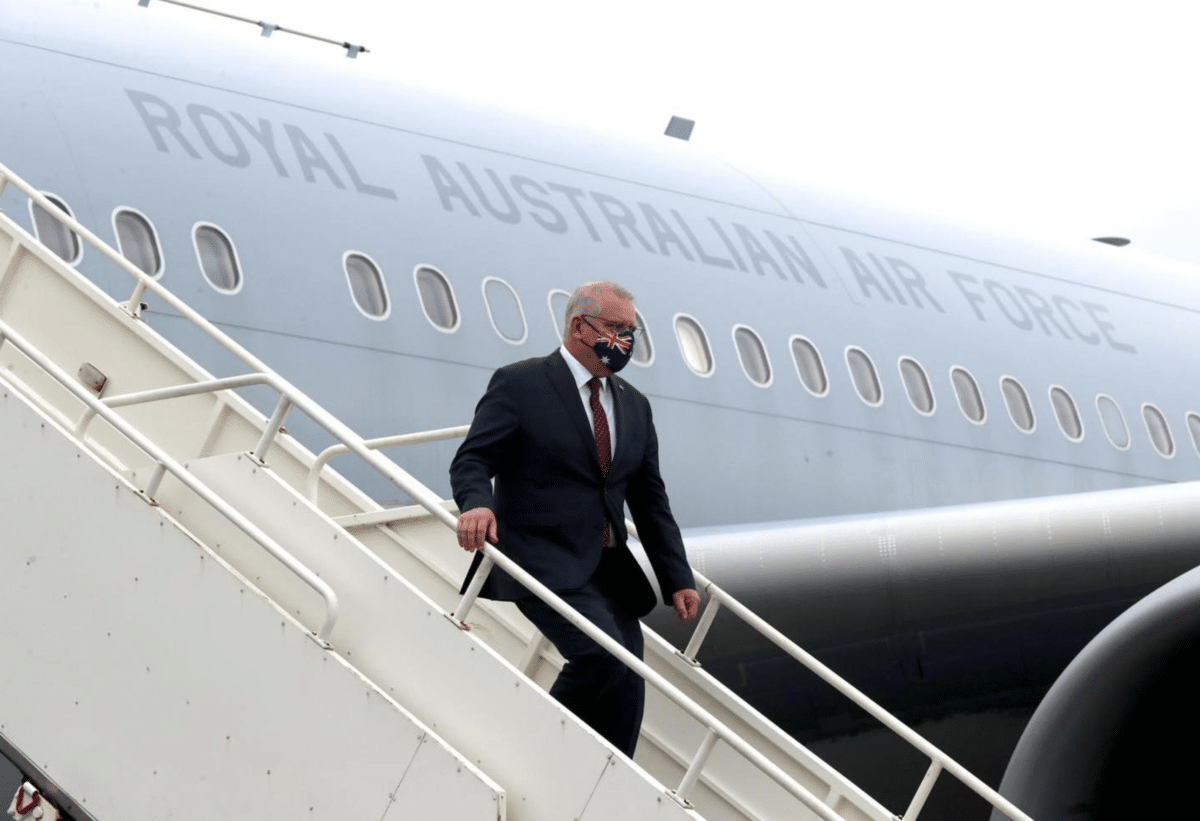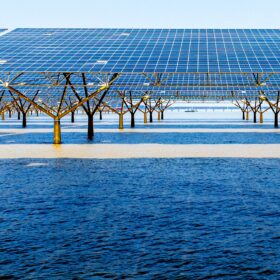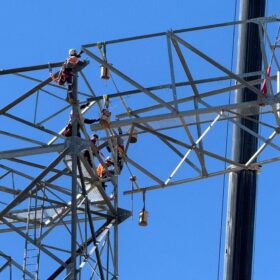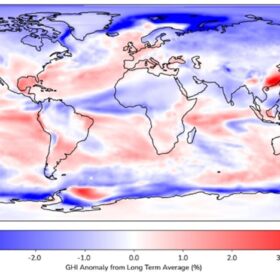Australian Prime Minister, Scott Morrison may be able to powder his nose with a new compact signed yesterday with German Chancellor Angela Merkel at the G7 Plus Summit in Cornwall yesterday, but the Joint Declaration of Intent (JDOI) to fast-track hydrogen co-operation between the two countries can’t cover his obfuscation on committing to a 2050 deadline for achieving net-zero emissions.
Morrison also met with Japan’s Prime Minister, Yoshihide Suga off the official agenda on Sunday and announced “a partnership on decarbonisation through technology”, which focuses on development and commercialisation of technologies such as carbon capture and storage, lower-emissions liquefied natural gas production, clean-fuel ammonia and again, green hydrogen.
Suga and Morrison’s joint statement described a technology-led response to climate change as critical to creating jobs and boosting economic growth, but while the statement reaffirmed Japan’s “commitment to transition to net zero emissions by 2050”, Australia reaffirmed its “commitment to achieve net-zero emissions as soon as possible, preferably by 2050”.
How to do commitment
In May, Germany brought its pursuit of a net-zero-emissions economy forward, strengthening interim annual targets and declaring a revised deadline of 2045. A statement announcing the German-Australian JDOI said that the demand for emission-free energy would be even greater than Germany’s leaders had previously envisaged.
Entities related to the German Fraunhofer Institute, including the Fraunhofer Institute for Solar Energy Systems, this month published a joint study which predicted that German demand for green hydrogen will boom to 80 TWh around 2030, to between 100 and 300 TWh in 2040, and reach some 800 TWh in 2050.
The study identified that the greatest growth sector of demand for hydrogen and hydrogen-based synthesis products (such as fuel-gas mixtures of hydrogen and carbon monoxide) will be industry — with up to 500 TWh of energy required for this German economic powerhouse sector by 2050.
“We are in the midst of an unparalleled revolution to decarbonise our industries,” confirmed Christoph von Spesshardt, Executive Director of the German-Australian Chamber of Industry and Commerce, yesterday. He added, “This joint declaration is building on an already established partnership between our two like-minded countries and will enable the decarbonisation of German and European industries.”
Australia can lead in green H2
The JDOI provides some added certainty of opportunity for investors in the development of clean hydrogen technology in Australia, where major new hydrogen ventures and commitments are announced at least weekly.
In May, the Australian Renewable Energy Agency (ARENA) committed more than $100 million to supporting construction of three large-scale renewable hydrogen plants; east-coast-focused clean energy company Pure Hydrogen is putting all the requirements in place to build the first of four large-scale green hydrogen plants, Project Jupiter, at the port of Gladstone; Australia’s national science agency, the CSIRO has committed $68 million to a “Hydrogen Industry Mission” dedicated to driving the cost of local green hydrogen below $2 per kilogram and establish the country as a leader in the global hydrogen economy by 2030; and Queensland electricity generator Stanwell this month partnered with Japan’s Iwatani Corporation and secured 236 hectares of land west of Gladstone to build a 3 GW hydrogen electrolysis plant.
“We know countries like Japan are looking to the Sunshine State to meet their emissions targets, and in the next decade, Queensland must be ready to capitalise,” Queensland’s Energy, Renewables and Hydrogen Minister, Mick de Brenni, said last week.
Having signed, the JDOI yesterday morning, Morrison told those assembled, that Australia’s “ambition is to produce the cheapest clean hydrogen in the world, which will transform transport, mining, resources and manufacturing at home and overseas”.
The coming CBAM wham!
But already other global emissions-reduction initiatives are threatening the competitiveness of Australia’s products on the world market.
On Friday, in advance of the G7 Plus meeting, the Australia Institute Climate & Energy Program published new analysis which shows that the introduction of carbon border adjustment mechanisms (CBAMs), which is also on the agenda for the gathering of leaders in Cornwall, “will put Australian industry and manufacturing processes — mainly steel, aluminium and alumina — at risk if Australia continues its recalcitrant role on the global stage”.
Scott Morrison had indicated he would warn world leaders against the use of carbon tariffs, on the basis that he considers carbon border adjustment mechanisms to be “protectionist”.
CBAMs are levies imposed on emissions-intensive imports by countries that themselves implement carbon pricing. The Australia Institute posits that an EU-proposed CBAM, which was to debut at the G7, is “not a tariff, and unlikely to be considered protectionist, as it is designed to comply with World Trade Organisation rules”.
This leaves Australia exposed to widespread implementation of CBAMs by countries that are concertedly steering their economies toward zero emissions by 2050 — it’s natural that as they invest in transitioning their industries to low-carbon processes, they will have no desire to support uncommitted freeloaders.
Australia remains one of only a few high-income countries that haven’t implemented or plan to implement a carbon price, but whose economies rely on the trading of energy-intensive products that will soon be taxed by more forward-thinking and future-invested countries.
Primary metals manufacturing industries are most exposed, says the Australia Institute, which points out that the emissions-intensive alumina and aluminium industries alone produce $12 billion per annum in export revenues for Australia.
Getting on the right side of the future
Economist Nicky Hutley, a spokesperson for the Australian Climate Council, added to the chorus urging more decisive Australian climate action on Friday, “By refusing to set net-zero targets, raise our Paris targets, or stop wasting taxpayer money on fossil fuels, the Australian government is leaving industries like manufacturing, energy and agriculture exposed to costly tariffs … and missing an opportunity to create 250,000 new jobs in the clean economy.”
On the positive side, “Carbon border adjustments in destination markets will assist Australia to develop new zero-emission export industries,” says international climate-policy expert Frank Muller, lead author of the Australia Institute report.
It’s in Australia’s interests to “engage constructively in the design of CBAMs and invest in clean production methods” for products such as steel and bauxite-to-aluminium processes which are currently heavily reliant on coal or gas for production, says the report.
So promising, so rudderless
The conclusions of the Australia Institute report authors — “Australia’s natural endowments and human resources position it better than most countries to prosper in a low-carbon world,” says Muller — echo the sentiments of the German-Australian Chamber, which supported negotiations toward the signing of yesterday’s JDOI:
“Australia, with its vast assets of renewable energy, is in a prime position to satisfy significant parts” of German industry’s burgeoning demand for green hydrogen.
It follows that it has the wherewithal to lead the development of green-metals and other products produced using renewable energy sources.
Riche Merzian, Climate & Energy Program Director at the Australia Institute put a warning twist on the Prime Minister’s prevailing narrative when he said in a statement accompanying the Institute’s report, “The Australian Government claims that its approach to climate is dictated by technology, not taxes. Make no mistake, if Australia continues to stonewall its trading partners and allies on climate, the taxes will come anyway” — the revenue will just be collected outside Australia.
A hydrogen agreement here, a $600 million gas plant there — such disparate approaches show Australia to be directionless and profligate in its attitude to climate change.
This content is protected by copyright and may not be reused. If you want to cooperate with us and would like to reuse some of our content, please contact: editors@pv-magazine.com.








That is a really good tip particularly to those new to the blogosphere.
Brief but very precise info… Many thanks for sharing this one.
A must read article!